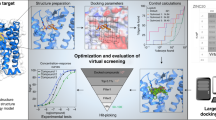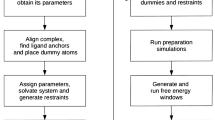Abstract
Computational docking can be used to predict bound conformations and free energies of binding for small-molecule ligands to macromolecular targets. Docking is widely used for the study of biomolecular interactions and mechanisms, and it is applied to structure-based drug design. The methods are fast enough to allow virtual screening of ligand libraries containing tens of thousands of compounds. This protocol covers the docking and virtual screening methods provided by the AutoDock suite of programs, including a basic docking of a drug molecule with an anticancer target, a virtual screen of this target with a small ligand library, docking with selective receptor flexibility, active site prediction and docking with explicit hydration. The entire protocol will require ∼5 h.
This is a preview of subscription content, access via your institution
Access options
Subscribe to this journal
Receive 12 print issues and online access
$259.00 per year
only $21.58 per issue
Buy this article
- Purchase on Springer Link
- Instant access to full article PDF
Prices may be subject to local taxes which are calculated during checkout






Similar content being viewed by others
References
Trott, O. & Olson, A.J. AutoDock Vina: improving the speed and accuracy of docking with a new scoring function, efficient optimization, and multithreading. J. Comput. Chem. 31, 455–461 (2010).
Goodsell, D.S. & Olson, A.J. Automated docking of substrates to proteins by simulated annealing. Proteins 8, 195–202 (1990).
Morris, G.M. et al. Automated docking using a Lamarckian genetic algorithm and an empirical binding free energy function. J. Comput. Chem. 19, 1639–1662 (1998).
Forli, S. Raccoon for Processing Virtual Screening <http://autodock.scripps.edu/resources/raccoon> (2013).
Morris, G.M. et al. AutoDock4 and AutoDockTools4: automated docking with selective receptor flexibility. J. Comput. Chem. 30, 2785–2791 (2009).
Harris, R., Olson, A.J. & Goodsell, D.S. Automated prediction of ligand-binding sites in proteins. Proteins 70, 1506–1517 (2008).
Sousa, S.F. et al. Protein-ligand docking in the new millennium—a retrospective of 10 years in the field. Curr. Med. Chem. 20, 2296–2314 (2013).
Goodsell, D.S., Lauble, H., Stout, C.D. & Olson, A.J. Automated docking in crystallography: analysis of the substrates of aconitase. Proteins 17, 1–10 (1993).
Goodsell, D.S., Morris, G.M. & Olson, A.J. Automated docking of flexible ligands: applications of AutoDock. J. Mol. Recognit. 9, 1–5 (1996).
Soares, T.A., Goodsell, D.S., Briggs, J.M., Ferreira, R. & Olson, A.J. Docking of 4-oxalocrotonate tautomerase substrates: implications for the catalytic mechanism. Biolpolymers 50, 319–328 (1999).
Rosenfeld, R.J. et al. Automated docking of ligands to an artificial active site: augmenting crystallographic analysis with computer modeling. J. Comput. Aided Mol. Des. 17, 525–536 (2003).
Brik, A. et al. Rapid diversity-oriented synthesis in microtiter plates for in situ screening of HIV protease inhibitors. ChemBioChem 4, 1246–1248 (2003).
Brik, A. et al. 1,2,3-Triazole as a peptide surrogate in the rapid synthesis of HIV-1 protease inhibitors. ChemBioChem 6, 1167–1169 (2005).
Perryman, A.L. et al. Fragment-based screen against HIV protease. Chem. Biol. Drug Des. 75, 257–268 (2010).
Cosconati, S. et al. Structure-based virtual screening and biological evaluation of Mycobacterium tuberculosis adenosine 5′-phosphosulfate reductase inhibitors. J. Med. Chem. 51, 6627–6630 (2008).
Perryman, A.L. et al. A virtual screen discovers novel, fragment-sized inhibitors of Mycobacterium tuberculosis InhA. J. Chem. Inf. Model. 55, 645–659 (2015).
Cosconati, S. et al. Identification of novel beta-secretase inhibitors through inclusion of protein flexibility in virtual screening calculations. FASEB J. 22, 791–798 (2008).
Cosconati, S. et al. Protein flexibility in virtual screening: the BACE-1 case study. J. Chem. Inf. Model. 52, 2697–2704 (2012).
Jiang, H. et al. Stabilizers of the Max homodimer identified in virtual ligand screening inhibit Myc function. Mol. Pharmacol. 76, 491–502 (2009).
Leonard, S.E., Garcia, F.J., Goodsell, D.S. & Carroll, K.S. Redox-based probes for protein tyrosine phosphatases. Angew. Chem. Int. Ed. Engl. 50, 4423–4427 (2011).
Huey, R., Goodsell, D.S., Morris, G.M. & Olson, A.J. Grid-based hydrogen bond potentials in improved directionality. Lett. Drug Des. Discov. 1, 178–183 (2004).
Huey, R., Morris, G.M., Olson, A.J. & Goodsell, D.S. A semiempirical free energy force field with charge-based desolvation. J. Comput. Chem. 28, 1145–1152 (2006).
Forli, S. & Olson, A.J. A force field with discrete displaceable waters and desolvation entropy for hydrated ligand docking. J. Med. Chem. 55, 623–638 (2012).
Bianco, G., Forli, S., Goodsell, D.S. & Olson, A.J. Covalent docking using autodock: two-point attractor and flexible side chain methods. Protein Sci. 25, 295–301 (2016).
Cosconati, S. et al. Virtual screening with AutoDock: theory and practice. Expert Opin. Drug Discov. 5, 597–607 (2010).
Lin, J.H., Perryman, A.L., Schames, J.R. & McCammon, J.A. The relaxed complex method: accommodating receptor flexibility for drug design with an improved scoring scheme. Biopolymers 68, 47–62 (2003).
Nagar, B. et al. Crystal structures of the kinase domain of c-Abl in complex with the small molecule inhibitors PD173955 and imatinib (STI-571). Cancer Res. 62, 4236–4243 (2002).
Schindler, T. et al. Structural mechanism for STI-571 inhibition of abelson tyrosine kinase. Science 289, 1938–1942 (2000).
Acknowledgements
This work was supported by the US National Institutes of Health (grant R01 GM069832 to A.J.O.). This is manuscript number 29118 from the Scripps Research Institute.
Author information
Authors and Affiliations
Contributions
All authors contributed equally to this work. D.S.G. and S.F. authored the protocol manuscript with extensive input from the other authors, based on tutorials developed by all authors. All authors have been instrumental in development of the AutoDock suite and training of users.
Corresponding author
Ethics declarations
Competing interests
The authors declare no competing financial interests.
Supplementary information
Rights and permissions
About this article
Cite this article
Forli, S., Huey, R., Pique, M. et al. Computational protein–ligand docking and virtual drug screening with the AutoDock suite. Nat Protoc 11, 905–919 (2016). https://doi.org/10.1038/nprot.2016.051
Published:
Issue Date:
DOI: https://doi.org/10.1038/nprot.2016.051
This article is cited by
-
Antioxidant, antibacterial, and molecular docking of methyl ferulate and oleic acid produced by Aspergillus pseudodeflectus AUMC 15761 utilizing wheat bran
Scientific Reports (2024)
-
Enhanced mapping of small-molecule binding sites in cells
Nature Chemical Biology (2024)
-
Carotenoid cleavage enzymes evolved convergently to generate the visual chromophore
Nature Chemical Biology (2024)
-
LC–MS profiling, in vitro and in silico C-ABL kinase inhibitory approach to identify potential anticancer agents from Dalbergia sissoo leaves
Scientific Reports (2024)
-
Computational design and genetic incorporation of lipidation mimics in living cells
Nature Chemical Biology (2024)
Comments
By submitting a comment you agree to abide by our Terms and Community Guidelines. If you find something abusive or that does not comply with our terms or guidelines please flag it as inappropriate.



